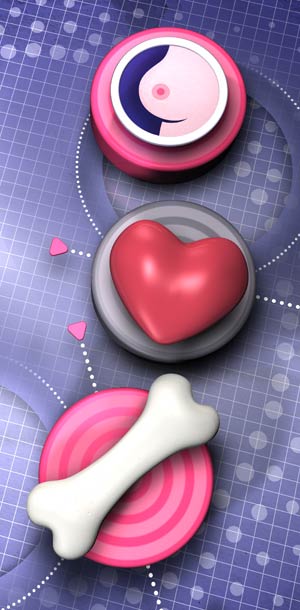
In 2017, the North American Menopause Society (NAMS) released a comprehensive summary of the evidence on the benefits
and risks of MHT.1 * The risks associated with MHT depend on the woman’s age or time since menopause, whether
oestrogen + progestogen or oestrogen alone is used, the formulation, dose, duration of use,† route of administration,
and personal and family risks of breast cancer, cardiovascular disease, stroke and venous thromboembolism.1
* The recommendations made by NAMS take into consideration findings
from the Women’s Health Initiative trials, other RCTs, meta-analyses of RCTs and observational studies. This does not
include additional analyses to provide overall risk estimates.
† Stroke and VTE risk do not appear to be affected by duration of treatment, but are influenced
by the woman’s age.1
No differences in all-cause mortality with MHT
An 18-year cumulative follow-up of the Women’s Health Initiative trials, which included over 27,000 women, found
no difference in all-cause, cardiovascular or total cancer mortality with either oestrogen + progestogen or oestrogen
alone MHT.6
N.B. These data were published after the 2017 NAMS guidance.
Breast cancer
Key points about breast cancer risk and MHT:1
- The Women’s Health Initiative trial found that oestrogen + progestogen MHT increased the risk of breast cancer
(an absolute increase of < 1 case per 1,000 woman-years). Further analysis showed that this increased risk was
only in women who had previously used MHT.
- Oestrogen-only MHT does not appear to increase breast cancer risk and some analyses have found possible reductions
in risk
- The risks of breast cancer may be increased with longer durations, e.g. more than seven years, and higher doses
of MHT.7 The risk decreases after stopping MHT.3
- There is some evidence that the breast cancer risk may be higher with continuous progestogen use than with cyclical
use8
- Micronised progesterone may be associated with a lower breast cancer risk than medroxyprogesterone
- The limited data available suggest that MHT does not further increase breast cancer risk in women at high risk,
e.g. due to family history or BRCA mutations
- Prior COC does not appear to increase the risk of breast cancer in women using MHT 9
- Other factors such as alcohol use and physical activity levels have also been shown to influence the risk of breast
cancer, and ways to reduce risk can be discussed with women4
Undergoing screening for breast cancer with mammography is recommended every two years for females aged
45–69 years.10
N.B. The International Menopause Society (IMS) released a statement regarding a 2019 analysis on the association
between MHT and increased breast cancer risk. The IMS noted that the analysis included primarily observational studies
using older MHT regimens that do not reflect current recommendations and therefore have limited applicability to current
practice. The statement is available here:
www.imsociety.org/manage/images/pdf/5054afeb9b1bc763032333443f1c0bed.pdf
Cardiovascular disease
Coronary heart disease (CHD):* The effects of MHT on CHD vary depending on the woman’s
age or time since menopause when treatment was initiated.1 For women aged < 60 years or fewer than 10
years since menopause, MHT may reduce the risk of CHD.1 A Cochrane review found a 30% relative risk reduction
in all-cause mortality and a nearly 50% relative risk reduction in CHD with MHT use when treatment was initiated within
ten years of menopause.11 Oestrogen alone appears to offer greater benefit than oestrogen + progestogen.3 These
treatment effects are no longer present when MHT is initiated more than ten years from menopause.11 For
women initiating MHT > 20 years since menopause, CHD risk may be increased, however, only in women taking combined
oestrogen + progestogen MHT.1
* Composite of death from cardiovascular causes and non-fatal myocardial infarction
Stroke: The risk of stroke associated with MHT depends on the woman’s age or time since menopause
when treatment was initiated.1 RCTs have shown no increased risk of stroke in women who start MHT aged < 60
years or within ten years of menopause, but an increased risk if initiated after age 60 years or more than ten years
from menopause.1 The Women’s Health Initiative trial found an absolute risk of stroke of < 1 per 1,000
woman-years in women aged < 60 years when they initiated MHT.1
Venous thromboembolism (VTE): Both oestrogen alone and oestrogen + progestogen MHT have been associated
with a higher VTE risk across all ages, however, the absolute risk of VTE in women aged < 60 years is small (approximately
1 per 1,000 women per year, increased to 2 per 1,000 women per year when using oral MHT).1, 12 Transdermal
oestrogen, as well as lower doses of oral or transdermal oestrogen, are associated with lower VTE risk.1 The
absolute risk of VTE increases with increasing age; other factors such as smoking and obesity also increase VTE risk.1
Bone fracture
The use of MHT is associated with small reduction in fracture risk (all fractures combined), with 44 and 53 fewer
fractures per 10,000 woman-years with oestrogen + progestogen and oestrogen alone, respectively, compared to placebo.13 This
reduced risk begins within the first few years of treatment.14, 15 However, women at high risk of fracture
should be prescribed bisphosphonates as a first-line treatment option, i.e. women with a previous fracture, a 10-year
risk of hip fracture ≥ 3% or T-score of ≤ –2.5 from a dual energy X-ray absorptiometry (DEXA) scan.16
N.B. Participants in the Women’s Health Initiative trials were not selected on the basis of having low bone density
or osteoporosis. MHT lowered fracture risk in women with normal or low bone mineral density, not just in those with osteoporosis.
Information to help patients to consider the risks and benefits of MHT is available from:





